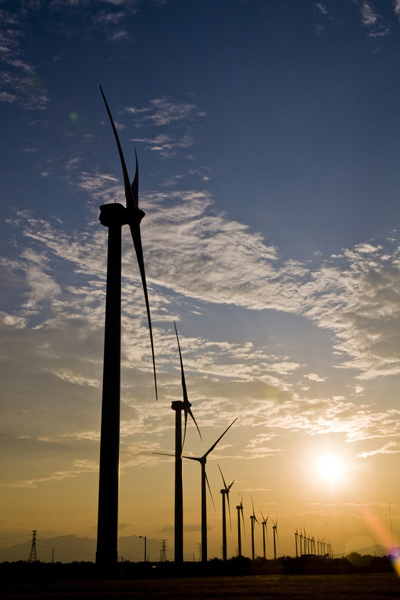
Policy
In March, the National People's Congress voted through the 12th Five-Year Plan (FYP) 2011–15 for National Economic and Social Development, hailed as the "Greenest FYP in China's history", with a third of the targets relating to environmental issues.
China surpassed the US to become the world's largest energy consumer in 2010, but environmental targets set out in the FYP include an increase in the proportion of primary energy generated by non-fossil fuels to 11.3 % by 2015, from the current 8.3%. To help meet this target, China intends to build at least 70GW of new wind farms and 5GW of new solar farms.
Access to finance
The latest statistics from Bloomberg New Energy Finance (BNEF) indicated that, in 2010, the China Development Bank (CDB) made around US$35 billion (€25b) in low-interest credit available to Chinese renewables companies. This compares with US$4 billion (€2.8 billion) of grants and US$16 billion (€11.4 billion) in loan guarantees awarded to cleantech companies in the US.
China's aid to the country's clean energy sector has been criticised, however; a complaint filed with the World Trade Organization in December 2010 by the US claimed that the assistance given to China's wind energy manufacturers violated global trade rules. Notwithstanding, the CDB agreed in March to lend 12 billion yuan (€1.3b) to the Linuo Group, a solar cell maker looking to expand its capacity tenfold.
Wind
China overtook the US at the end of 2010 to become the world leader in wind power installations. The latest Global Wind Energy Council (GWEC) statistics show that China installed around 16GW in 2010--representing almost half of global installations--taking cumulative installed capacity to 42GW. This is contrasted with an additional 5GW installed in the US last year and a total capacity of 40GW.
However, China ranks second globally in terms of grid-connected capacity; more than a third of wind capacity had yet to be connected to the national grid at the end of 2010. Grid operators are required by law to buy all output from renewable projects. But grid planning lags behind wind power developments, and often the regions with abundant wind power are far from populated or industrial areas. China will therefore require extensive grid upgrades to take advantage of the estimated 300GW of technically exploitable onshore wind resource.
Q1 saw the tightening of rules over turbine manufacturing in a bid to control overcapacity and prevent prices being forced down. Local investment bureaus have been asked not to approve the construction of new turbine production plants, excluding the expansion of existing facilities. This follows a policy implemented last year, which ruled that government support will be awarded only for the production of turbines 2.5MW or greater.
Offshore wind
Onshore wind grid issues and support for large-scale turbine manufacture has enabled enthusiastic provincial governments to persuade national authorities of the potential for offshore wind in China's energy mix. While the market is still in its infancy with only a single operating project--the 102MW Donghai Bridge plant near Shanghai--strong growth is forecast in the next decade.
Provincial governments suggest that 30GW by 2020 is a realistic target, and developers will be able to take advantage of the offshore feed-in tariffs (FIT) of 0.62-0.73 yuan (€0.07–€0.08) per kWh. The National Development and Reform Commission (NDRC) has recently awarded licences to build four offshore wind farms in eastern China's Juangsu Province. These include two 200MW projects located at Daefeng and Dongtai, a 300MW wind farm site at Sheyang and another 300MW project to be built at Binhai.
Solar
Japan's nuclear disaster has prompted the National Development and Reform Commission (NDRC) to call for an increase in China's solar capacity target from 20GW to 50GW by 2020. There is pressure on China to develop its own solar market and reduce reliance on the export of components, amid concerns that cuts to European FIT schemes and a growing supply chain in the US could lead to an oversupply of panels.
Solar CSP
In a bid to further diversify its energy mix, China is preparing its second concentrated solar power (CSP) tender--a 92MW project in Yulin City. The project will cost around US$300 million (€213m) and utilise US technology developed by ESolar Inc. ESolar has also announced that it plans to co-invest US$915 million (€649m) to build the 300MW Fuxin solar thermal power project.
China is using competitive bidding rather than European-style subsidised FITs in order to reduce power prices: the Government's first CSP tender generated an average solar power price of 0.96 yuan (€0.104) per kWh compared with €0.475 in Spain, although this is still double the price of conventional power. The larger state-owned utilities appear to be content, in the short term at least, to sacrifice financial return for the opportunity to gain expertise. However, China has indicated that it will spend the next year studying Europe's premium payment schemes for solar power in order to determine the most effective incentive system.
This article is from the "Renewable energy country attractiveness indices" (CAI) report, firstpublished in May 2011, and reproduced with permission from Ernst & Young. Please contact Ben Warren and Phil Dominy if you would like more information on this report.
By : Ben Warren and Phil Dominy, Ernst & Young